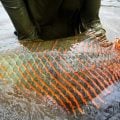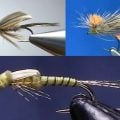How to Use Wet Flies and Nymphs
“Now you know people say that trout feed 90% of the time underwater and that may be true. The problem is we don’t usually know what they’re eating, so there’s a lot of mystery involved and a lot of trial and error. Join us and we’ll show you some tips on subsurface fishing for trout….
150 years ago trout fishing was done solely with what today we would call traditional winged wet flies. Anglers fished as many as 10 of them on a single leader and even cast them over rising fish with success. Then people began experimenting with floating flies a little over a hundred years ago. And this concentration on more exacting imitations of insects and crustaceans gave rise to the nymph—really just another kind of wet fly but usually without wings. Today we fish wet flies and nymphs interchangeably, but wet flies are more often swung in the current than fished dead-drift.
Fishing a wet fly or nymph on the swing—in other words across and downstream on a tight line—is both a return to a more traditional way of fishing with a fly and a relaxing and elegant way to fish. One of the really pleasant things about about fishing a wet fly is that they don’t have any air resistance at all, and so they don’t have as much air resistance as a dry. And unlike most nymph fishing you don’t have an indicator weight on the leader, so the casting is just really easy and pleasant.
Because trout often take the fly in a tight line this take is felt immediately and fish often hook themselves. It’s also a great way to cover a lot of water when you’re not sure where the fish are. This kind of fishing a sunken fly works best in shallow water with a gentle riffle, and it’s tougher with conflicting currents and in very deep water. Wet fly fishing is also most productive when you see the occasional rise. I’m just letting that I don’t even really have to make a mend in this nice slow water. I can just let that fly—oh there’s one, oh we lost ’em. I don’t even need to mend, this water is so nice and gentle and uniform, I can just let that fly swing across the current, although most of the time when you fish nymphs you strive to eliminate drag on the fly.
When swinging a wet fly the drag is subtle and controlled. Some aquatic insects can swim. A swung wet flight could imitate a tiny baitfish or it might also imitate an aquatic insect rising to the surface to hatch. We don’t know exactly why fish take a wet fly but that’s part of the fun.”
How to Use Thread Wax
How to Whip a Loop in the End of Your Fly Line











